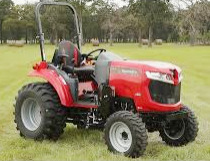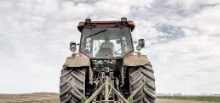________________________________________________________________________________________
| Home / Farm Tractors / Mahindra Tractors / Mahindra 1635 |
Mahindra 1635 Troubleshooting
 The
Mahindra 1635 compact utility tractor was manufactured between 2018 and 2023.
The Mahindra 1635 tractor is powered by 4-cycle 3-cylinder direct injection
naturally aspirated diesel engine. A 125 cubic inches (2 L) engine has a
cylinder bore of 3.5" (89 mm), piston stroke of 4.33" (110 mm), and rated power
of 36 hp (27 kW). The Mahindra 1635 is fitted with a 2 transmission options: 8x8
synchro shuttle transmission, or 3-range hydrostatic transmission. The maximum
forward speed - 14.9 mph (23.8 km/h), maximum reverse speed - 12.2 mph (19.5
km/h).
The
Mahindra 1635 compact utility tractor was manufactured between 2018 and 2023.
The Mahindra 1635 tractor is powered by 4-cycle 3-cylinder direct injection
naturally aspirated diesel engine. A 125 cubic inches (2 L) engine has a
cylinder bore of 3.5" (89 mm), piston stroke of 4.33" (110 mm), and rated power
of 36 hp (27 kW). The Mahindra 1635 is fitted with a 2 transmission options: 8x8
synchro shuttle transmission, or 3-range hydrostatic transmission. The maximum
forward speed - 14.9 mph (23.8 km/h), maximum reverse speed - 12.2 mph (19.5
km/h).
The open center hydraulic system includes a gear pump with rated fluid flow of 7.7 gal/min (29 l/min). The tractor is equipped with a hydrostatic power steering system, wet disc brakes, 28x8.5-15 front tyres, and 43x16-20 rear tyres. The wheelbase is 77 inches (1955 mm). The tractor is compatible with 72" mid-mount side discharge 3-blade Mahindra 1672M mower deck with cutting height of 1.0-4.0 in (25-102 mm), Mahindra 1635L front loader with maximum lift height of 87" (2200 mm), and Mahindra 1635B backhoe with maximum digging depth of 86" (2180 mm).
| Engine Troubleshooting |
| Engine difficult to start or doesn't start |
Air in the fuel pipes - Bleed the fuel pipes.
Dirty fuel filter - Filter maintenance required.
Fuel injection nozzles are faulty or clogged - Clean or replace injection nozzles.
Water in the fuel system - Change fuel and repair fuel system.
Incorrect valve clearance - Have it adjusted.
Fuel injection pump damage - Repair or replace injection pump.
| Diesel starts but immediately shuts off |
Plugged air filter - Carry out maintenance on air filter.
Fuel filter element is clogged - Install new filter element.
Poor fuel injection pump tightness - Look for any leaks of fuel pump Tighten it fast.
Fuel injectors are faulty or clogged - Replace or clean fuel injectors.
Fuel injection pump damage - Change pump or rebuild it.
| Engine stalls during operation |
Low coolant temperature - Warm up to required temperature.
Fuel filter element clogging - Replace filter element.
Air trapped in fuel system - Bleed air.
Fuel injection nozzles fault - Clean or change injection nozzles.
Improper fuel injection timing - Set up as recommended.
| Engine stalls when idle |
Incorrect low idle setting - Adjust the low idle speed.
Fuel injection pump malfunctioning - Rebuild or install a new injection pump.
Fuel injectors are faulty or clogged - Replace fuel injectors.
Valve clearance is not correct - Check and adjust.
| Engine is not running at maximum power |
Clogged air filter - Change air filter element.
Fuel injection nozzles fault - If necessary, replace with a new nozzle.
Insufficient fuel injection pressure - Repair or replace injection pump.
Excessive valve clearance - Adjust valve clearance according to specifications.
Incorrect low idle speed adjustment - Need to adjust idle speed.
Dirt in the fuel lines or hoses - Clean fuel hoses and lines.
Leaking cylinder head gasket - Install new cylinder head gasket.
Piston rings are worn or damaged - Replace piston rings.
| Engine overheating |
Insufficient coolant - Top up coolant fluid and check system for leaks.
Low engine oil level - Check and refill engine oil.
Dirty radiator fins or defective radiator cap - Install new cap or clean radiator.
Excessive wear of the fan belt - Fan belt must be replaced.
Engine overload - Reduce load or shift to lower gear.
| Low oil pressure |
Oil level is insufficient - Need to add oil.
Engine oil filter is plugged - Clean or change engine oil filter.
Improper type of engine oil - Use the specified type of engine oil.
Incorrect oil clearance in main bearing - Replace bearings.
Defective oil pump - Replace as required.
| Abnormal engine noise or knocking |
Low engine oil level - Add oil to the engine crankcase.
Engine is cold - Normalize the temperature by warming up the engine.
Improper setting of fuel injection pump timing - Adjust the pump as required.
Low idle speed setting is incorrect - Correct low idle adjustment.
Defective fuel injectors - Clean fuel injectors or change it.
Faulty or misaligned connecting rod - Connecting rod must be aligned or replaced.
Scored or worn pistons - Replace the pistons as required.
| Transmission Troubleshooting |
| Transmission fluid pressure is insufficient |
Transmission oil level is low - Check transmission oil level and add oil as required.
Clogged transmission oil filter element (if fitted) - Clean or replace the transmission filter.
Defective relief valve - Replace relief valve.
| Transmission is making noise |
Insufficient transmission oil - Add oil to the transmission housing.
Transmission oil is dirty - Transmission oil change required.
Worn gears or incorrect backlash - Replace defective gears or set backlash properly.
Worn or cracked bearings - Faulty bearings should be changed.
Worn or damaged gear shift forks - Shift forks need to be changed.
Shaft splines are damaged or worn - Change the shaft.
| Hard to shift gears |
Worn or rusty gear shift linkage - Replace or lubricate the shift linkage.
Worn or damaged gear shift forks - Install new shift forks.
Gearshift mechanism is damaged - Replace or repair the mechanism.
Worn or improperly adjusted clutch - Clutch adjustment or replacement required.
| External fluid leaks |
Transmission oil level is exceeded - Correct the oil volume.
Damaged seals or gaskets - Install new components.
| Hydrostatic Transmission Troubleshooting |
| Excessive HST transmission noise |
Insufficient oil level or contaminated oil - Fill to required level or change the transmission oil.
Speed control linkage is worn or unadjusted - Adjust or change linkage.
Stuck relief valve - Change the valve.
Transmission is under excessive load - The load should be reduced.
Transmission components are damaged or worn - After disassembling and inspection, change defective components.
| Loss of power |
Lack of transmission oil supply - Check and refill the transmission oil.
Relief valve failure - Change the valve.
Speed control linkage is defective or unadjusted - Adjust or install new linkage.
| Transmission oil over heats |
Lack of transmission fluid - Check and refill the transmission fluid.
Transmission oil filter is dirty - Clean or replace the transmission filter.
Plugged or defective cooling components - Check all cooling components and clean or replace if required.
Transmission overload - The load should be reduced.
| Transmission oil leakage |
Worn seals or gaskets - Install new components.
Internal transmission housing pressure is too high - Repair or replace damaged components.
Plugged transmission fluid return tube - Service or replace return tube.
| Hydraulic System Troubleshooting |
| Low hydraulic system pressure |
Insufficient hydraulic oil - Fill the system to proper hydraulic oil level.
Hydraulic oil filter is clogged - Replace hydraulic filter element or service if necessary.
Hydraulic pump is defective - Repair or replace hydraulic fluid pump.
Not adjusted hydraulic control valve - Need to adjust.
Hydraulic cylinder not working - Repair or replace hydraulic cylinder.
Leaking hydraulic lines - Inspect hydraulic system for leaks and repair it.
| Hydraulic system overheats |
Main relief valve malfunctioning - Replace relief valve.
Hydraulic fluid type is incorrect - Pour the correct type of fluid.
Contaminated hydraulic oil - Change hydraulic oil.
Air in hydraulic system - Bleed air from hydraulic system.
| Hitch not raising or hitch raises slowly |
Excessive hitch loading - The load should be reduced.
Hydraulic fluid level low - Add fluid as required.
Clogged hydraulic oil filter element - Hydraulic filter maintenance required.
Hydraulic pump is defective - Repair or replace hydraulic oil pump.
Damaged main relief valve - Replace relief valve.
Damaged hydraulic control valve - Repair or replace hydraulic valve.
Hydraulic cylinder not working - Replace or repair hydraulic cylinder.
Disconnected or broken suction line - Change or connect properly.
| Hitch cannot be dropped or dropping is too slow |
Hydraulic spool valve is out of adjustment - Spool valve adjustment required.
Hydraulic cylinder is faulty - Repair or replace hydraulic cylinder.
Hitch is out of adjustment - Adjust the hitch.
Worn hitch rock shaft - Replace the shaft.
| Hitch lower or lift is jerky |
Air in hydraulic pipes - Bleed hydraulic pipes.
Hydraulic oil is contaminated - Fill up with fresh hydraulic oil.
Hydraulic pump is defective - Change or repair hydraulic fluid pump.
Defective hydraulic spool valve block - Install a new valve or repair it.
Hydraulic cylinder failure - Change or repair hydraulic cylinder.
| Steering Troubleshooting |
| Excessive effort to steer |
Damaged or incorrectly assembled steering column - Replace steering column or assemble correctly.
Air in the hydraulic steering system - Bleed the steering system.
Not adjusted toe-in - Adjust toe-in wheels.
Uneven tyre pressure - Inflate the tyres properly.
Steering pump failure - Repair or change steering pump.
Steering pump control valve is worn or stuck - Flush or change flow control valve.
Steering oil level is insufficient - Checking steering oil level and add it if necessary.
| Excessive steering wheel free play |
Steering column coupling or shaft is worn - Change defective component.
Steering pump failure - Install a new hydraulic steering pump.
Steering linkage parts are loose or worn - Check and replace as required.
| Front wheels wander to right or left |
Uneven tire pressure - Inflate the tires properly.
Incorrect toe-in - Adjust toe-in wheels.
Loose or worn steering linkage components - Check and change as required.
Defective or improperly adjusted front wheel bearings - Change or adjust bearings correctly.
| Electrical Troubleshooting |
| Battery is not charging |
Electrical cable connections are loose or corroded - Tighten or clean electrical wiring connections.
Electrical terminal connectors are defective - Terminal connectors need to be changed.
Battery failing - Battery change required.
Worn or loose belt - Adjust belt tension or change the belt.
| Starter turns slow |
Low battery output - Recharge the battery.
Battery is not holding charge - Battery needs service or replacement.
Disconnected cables or faulty battery terminals - Connect cables correctly or replace terminals.
| Starter motor won't turn |
Battery is discharged or worn - Battery needs to be recharged or replaced.
Wiring is improperly connected or disconnected - Check wiring and connect properly.
Battery voltage is low - Battery is drained, recharge it.
Starter motor failing - Starter needs to be replaced.
________________________________________________________________________________________
________________________________________________________________________________________
| Farm Tractors Technical Specifications |
